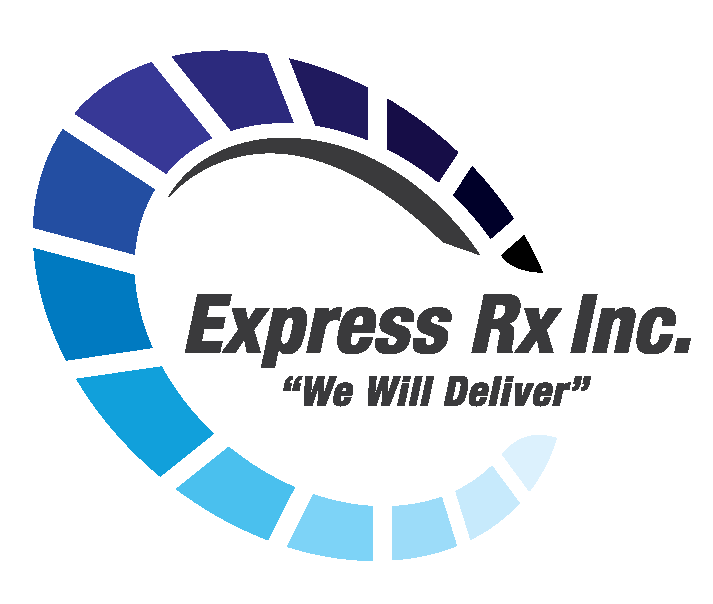Patient/Caregiving Instructions
Home Safety Instructions
Patient Rights
To ensure the finest care possible, as a Patient receiving Durable Medical Equipment (DME), you should understand your role, rights and responsibilities involved in your own plan of care.
Patient Responsibilities
- To provide accurate and complete information regarding your past and present medical history.
- To agree to a schedule of services and report any cancellation of scheduled appointments and/or treatments.
- To participate in the development and updating of a plan of care.
- To communicate whether you clearly comprehend the course of treatment and plan of care.
- To comply with the plan of care and clinical instructions.
- To accept responsibility for your actions, if refusing treatment or not complying with, the prescribed treatment and services.
- To respect the rights of Pharmacy & DME personnel.
- To notify your Physician and Express Rx team with any potential side effects and/or complications.
Patient Complaints and Grievances Policy
The patient has the right to freely voice grievances and recommend changes in care or services without fear of reprisal or unreasonable interruption of services. Patients and caregivers have the right to have all complaints heard, investigated and resolved.
A complete report of the initial complaint and subsequent investigation and resolution is to be kept by the Compliance Manager in a secure file, and a summary is documented in the patients file. All service, equipment, and billing complaints will be communicated to management and upper management.
All complaints will be handled in a professional manner. All logged complaints will be investigated, acted upon, and responded to in writing or by telephone by a manager within a reasonable amount of time after the receipt of the complaint. The process will involve interviewing staff, reviewing delivery van logs, checking patients file including delivery slips and other documentations.
The patient will be informed of this complaint resolution protocol at the time of set-up of service.
A patient/client may file a complaint or grievance by calling customer service.
Emergency Policies and Procedures
Please call us a minimum of 24 hours in advance if you need an oxygen delivery. While we are available 24 hours a day by telephone, if you have a respiratory equipment problem or need Oxygen, we may take up to two hours to arrive at your residence during non-business hours. It is always better to plan ahead!
In the case of a disaster or extremely severe weather, which results in a long-term (more than 4 hours) power outage, we will attempt to contact you to assess your needs & our ability to serve you safely.Remember, you are ultimately responsible for residing in a location that has adequate electrical service. Please develop a plan now to move, taking our equipment with you, to a location that has adequate electrical service. We suggest you always have a Portable, battery-powered radio available to monitor the weather & a flashlight, both with fresh batteries.
If you have a medical emergency, we suggest you call 911. Do not call us, our staff does not provide CPR. Should you have Advance Directives or a Do Not Resuscitate (DNR) order, please provide us with a copy & a copy of those orders should be available at all times for emergency personnel.
Billing and Reimbursement Practices
All product deliveries are made, as requested by the client, and authorised by insurance company, medical group, IPA, doctor or doctors representative until the item(s) are no longer medically necessary, and/or the client is deemed ineligible to receive the supplies.
- On day of the scheduled delivery, the clients insurance eligibility is verified to ensure coverage for products to be delivered.
- If the client is ineligible on the date of service, the supplies requested CANNOT be delivered.
- Deliveries may resume as soon as the client is determined to be eligible again.
- If you request an item or supply which is deemed non- covered by your insurance, it will be required, to be paid for, prior to delivery. We accept Money Order, Visa or MasterCard
Rental/Purchased Products
Certain rental products are converted to purchase after 13 months of continuous payments.However, if the beneficiaries eligibility changes, and/or authorization for product expires, or beneficiary no longer needs the use of the product prior to the transfer of ownership to the beneficiary, the beneficiary is responsible for returning the product to Express Rx Inc in working condition and complying with requests by Express Rx Inc for product pick up.
In the event that the beneficiary refuses to return the rental product in a timely manner, Express Rx Inc reserves the right to bill beneficiary directly for the full cost of the product. The beneficiary will be responsible for making payment to Express Rx Inc.
Certain products do not fall under the capped rental. These products are continuous rentals and ownership of these products DOES NOT transfer to the beneficiary. Examples may include, but are not limited to oxygen concentrator, oxygen tanks, etc.
If the beneficiaries eligibility changes, and/or authorization for product expires, or beneficiary no longer needs the use of the product, the beneficiary is responsible for returning the product to Express Rx Inc in working condition and complying with requests by Express Rx Inc for product pick up.
In the event that the beneficiary refuses to return the rental product in a timely manner, Express Rx Inc reserves the right to bill beneficiary directly for the full cost of the product. The beneficiary will be responsible for making payment to Express Rx Inc.
Rental products must be returned if ownership had not been transferred to the beneficiary. Please see page 38 for specifics about your products.
Purchase
CANES
- Cane Adjust / Fix with Tip
- Cane Adjust / Fix Quad / 3 Pro
- Crutches
- Crutch Forearm Pair
- Crutch Underarm Pair No Wood
WALKERS
- Walker Folding Adjust / Fix
- Walker Folding Wheeled w/o Seat
- Heavy-duty Walker No Wheels
- Heavy-duty Walker Wheeled Walker
COMMODES
- Commode Chair, Mobile or Stationary
- Heavy-duty / Wide Commode Chair
BATH & TOILET AIDS
- Grab Bar
- Raised Toilet Seat
- Shower / Tub Bench or Stool
- Transfer Bench
- Overbed Table
OXYGEN MISC.
- Regulator
- Stand / Rack
BI-PAP AND CPAP SUPPLIES
- CPAP Full Facemask
- Replacement Facemask Interface
- Replacement Nasal Cushion
- Replacement Nasal Pillows
- Nasal Applicator Device
- Pos Airway Press Headgear
- Pos Airway Press Chinstrap
- Pos Airway Press Tubing
- Pos Airway Press Filter
- Filter Non Disposable w/ Pap
- PAP Oral Interface
- Replacement Exhalation Port for PAP
- Replacement Water Chamber PAP Device
- Nebulizer w/ Compressor
- Enteral Infusion Pump w/ Alarm
- Enteral I.V. Pole
Medicare DMEPOS Supplier Standards
1. A supplier must be in compliance with all applicable federal and state licensure and regulatory requirements.
2. A supplier must provide complete and accurate information on the DMEPOS supplier application. Any changes to this information must be reported to the National Supplier Clearinghouse within 30 days.
3. An authorised individual (one whose signature is binding) must sign the enrolment application for billing privileges.
4. A supplier must fill orders from its own inventory or must contract with other companies for the purchase of items necessary to fill the order. A supplier may not contract with any entity that is currently excluded from the Medicare program, any State health care programs or from any other federal procurement or non-procurement programs.
5. A supplier must advise beneficiaries that they may rent or purchase inexpensive or routinely purchased durable medical equipment and of the purchase option for capped rental equipment.
6. A supplier must notify beneficiaries of warranty coverage and honor all warranties under applicable state law and repair or replace free of charge Medicare covered items that are under warranty.
7. A supplier must maintain a physical facility on an appropriate site and must maintain a visible sign with posted hours of operation. The location must be accessible to the public and staffed during posted hours of business. The location must be at least 200 square feet and contain space for storing records.
8. A supplier must permit CMS or its agents to conduct on-site inspections to ascertain the supplier's compliance with these standards.
9. A supplier must maintain a primary business telephone listed under the name of the business in a local directory or a toll free number available through directory assistance. The exclusive use of a beeper, answering machine, answering service or cell phone during posted business hours is prohibited.
10. A supplier must have comprehensive liability insurance in the amount of at least $300,000 that covers both the supplier's place of business and all customers and employees of the supplier. If the supplier manufactures its own items, this insurance must also cover product liability and completed operations.
11. A supplier is prohibited from direct solicitation to Medicare beneficiaries. For complete details on this prohibition see 42 CFR 424.57 (c) (11).
12. A supplier is responsible for delivery and must instruct beneficiaries on use of Medicare covered items and maintain proof of delivery and beneficiary instruction.
13. A supplier must answer questions and respond to complaints of beneficiaries and maintain documentation of such contacts.
14. A supplier must maintain and replace at no charge or repair directly or through a service contract with another company Medicare-covered items it has rented to beneficiaries.
15. A supplier must accept returns of substandard (less than full quality for the particular item) or unsuitable items (inappropriate for the beneficiary at the time it was fitted and rented or sold) from beneficiaries.
16. A supplier must disclose these standards to each beneficiary it supplies a Medicare-covered item.
17. A supplier must disclose any person having ownership, financial or control interest in the supplier.
18. A supplier must not convey or reassign a supplier number (i.e., the supplier may not sell or allow another entity to use its Medicare billing number).
19. A supplier must have a complaint resolution protocol established to address beneficiary complaints that relate to these standards. A record of these complaints must be maintained at the physical facility.
20. Complaint records must include the name, address, telephone number and health insurance claim number of the beneficiary; a summary of the complaint; and any actions taken to resolve it.
21. A supplier must agree to furnish CMS any information required by the Medicare statute and implementing regulations.
22. All suppliers must be accredited by a CMS-approved accreditation organization in order to receive and retain a supplier billing number. The accreditation must indicate the specific products and services for which the supplier is accredited in order for the supplier to receive payment of those specific products and services (except for certain exempt pharmaceuticals).
23. All suppliers must notify their accreditation organization when a new DMEPOS location is opened.
24. All supplier locations, whether owned or subcontracted, must meet the DMEPOS quality standards and be separately accredited in order to bill Medicare.
25. All suppliers must disclose upon enrollment all products and services, including the addition of new product lines for which they are seeking accreditation.
26. A supplier must meet the surety bond requirements specified in 42 C.F.R. 424.57(c).
27. A supplier must obtain oxygen from a state-licensed oxygen provider.
28. A supplier must maintain ordering and referring documentation consistent with provisions found in 42 C.F.R. 424.516(f)
29. A supplier is prohibited from sharing a practice location with other Medicare providers and suppliers.
30. A supplier must remain open to the public for a minimum of 30 hours per week except physicians (as defined in section 1848 (j) (3) of the Act) or physical and occupational therapists or a DMEPOS supplier working with custom made orthotics and prosthetics.
Patient Privacy Rights
1. Availability of EXPRESS RX PHARMACY & MEDICAL SUPPLIESs Privacy Notice: The patient has the right to receive our privacy notice in a timely manner. Upon request, the patient may at any time receive a paper copy of our privacy notice, even if he or she earlier agreed to receive the notice electronically. We must also post our privacy notice in a prominent location. 1b. Availability of EXPRESS RX PHARMACY & MEDICAL SUPPLIESs Privacy Notice: The insured has the right to receive our privacy notice in a timely manner. In addition, we must inform insureds how to obtain the privacy notice that is relevant to them.
2. Requesting Restrictions on Certain Uses and Disclosures: The patient has the right to object to, and ask for restrictions on, how his or her health information is used or to whom the information is disclosed, even if the restriction affects the patients treatment or our payment or health care operation activities. The patient may want to limit the health information that is included in patient directories, or provided to family or friends involved in his or her care or payment of medical bills. The patient may also want to limit the health information provided to authorities involved with disaster relief efforts. However, we are not required to agree in all circumstances to the patients requested restriction.
3. EXPRESS RX PHARMACY & MEDICAL SUPPLIES Receiving Confidential Communication of Health Information: The patient has the right to ask that we communicate his or her health information to them in different ways or places. For example, the patient may wish to receive information about their health status in a special, private room or through a written letter sent to a private address. We must accommodate requests that are reasonable in terms of administrative burden. We may not require the patient to give a reason for the request.
3. EXPRESS RX PHARMACY & MEDICAL SUPPLIES Receiving Confidential Communication of Health Information: The insured has the right to ask that we communicate his or her health information to them in different ways or places. We must accommodate requests that are reasonable in terms of administrative burden, if the individual has made a statement that disclosure of the health information could put them in danger. HIPAA The purpose of this document is to outline and educate EXPRESS RX PHARMACY & MEDICAL SUPPLIES about the policies and procedures needed to comply with the patient privacy rights enacted under the Health Insurance Portability and Accountability Act of 1996 (HIPAA). More detailed documents discussing our policies and procedures for each of these rights are available to all employees. It is the policy of EXPRESS RX PHARMACY & MEDICAL SUPPLIES to implement the following policies and procedures that will ensure patient privacy rights in accordance with the Privacy Regulations put into effect under HIPAA: PURPOSE POLICY 13
4. EXPRESS RX PHARMACY & MEDICAL SUPPLIES Access, Inspection and Copying of Health Information: Patients have the right to inspect and obtain a copy of their health information. In addition, we may charge the patient a reasonable cost-based fee for copies of their health information. 4b. EXPRESS RX PHARMACY & MEDICAL SUPPLIES Access, Inspection and Copying of Health Information: With a few exceptions, insureds have the right to inspect and obtain a copy of their health information. However, this right does not apply to psychotherapy notes or information gathered for judicial proceedings, for example. In addition, we may, under certain conditions, charge the patient a reasonable fee for copies of their health information.
5. Requesting Amendments or Corrections to Health Information: If the patient believes their health information is incomplete or incorrect, they may ask us to correct the information. The patient may be asked to make such requests in writing and to give a reason as to why his or her health information should be changed. However, if we did not create the health information that the patient believes is incorrect, or if we disagree with the patient and believe his or her health information is correct, we may deny the request. We must act on the request within 60 days after we receive it, unless we inform the patient of our need for a one-time 30-day extension.
6. Receiving an Accounting of Disclosures of Health Information: In some limited instances, the patient has the right to ask for a list of the disclosures of their health information that we have made while we maintained their protected health information in their designated record set. This list must include the date and time of the received request, date and time of the disclosure, who received the disclosed health information, a brief description of the health information disclosed, and why the disclosure was made. We must furnish the patient with a list within 60 days of the request, unless we inform the patient of our need for a one-time 30-day extension or upon reasonable notice, and we may not charge the patient for the list, unless the patient requests such list more than once in a 12 month period.
7. Complaints: Patients have the right to file a complaint with us and with the federal Department of Health and Human Services if they believe their privacy rights have been violated. We will not retaliate against the patient for filing such a complaint. To file a complaint with either entity, the patient should contact MARK ZALTSMAN, who will provide the patient with the necessary assistance and paperwork.
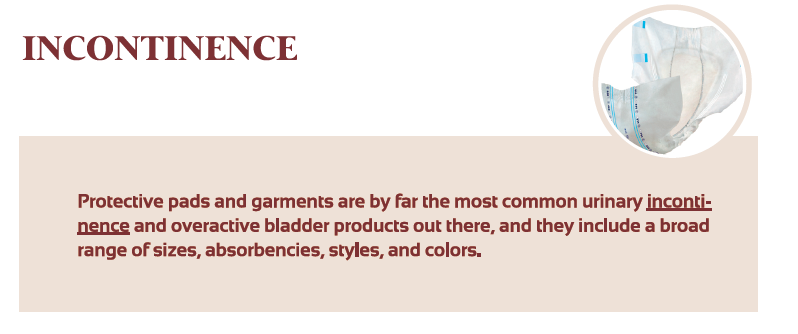

General Information:
____Patient and caregivers that will operate equipment will participate in training; no one else should operate equipment.
Patient/Caregiver Can Demonstrate:
____ Unfolding of wheelchair into usable position; demonstrate wheel locks (brakes)and note that they must be in place when patient enters and exits chair.
____ Removal and attachment of removable arms, if applicable.
____ Attachment of leg/foot rests, and how to swing away and lock them.
____ Seating of patient in chair and adjustment of foot plates.
____ Exit of patient from chair, using locks and transfer technique.
____ Folding of chair for transport in vehicle or storage. If applicable, demonstrate or describe loading of chair into rear seat of automobile.
Safety/Maintenance:
____ Discuss need to check wheelchair for proper function to ensure safety.
____ Demonstrate potential hazards of equipment: i.e., loss of balance on curbs or ramps with resultant backward tipping, rolling of chair out from under patient when failing to set locks, pinch points, etc.
____ Discuss need to keep chair clean and protect from elements.
____ Emphasize importance of notification of Express Rx in the event of malfunction or faulty parts on unit.
____ Ensure that patient and caregivers have information necessary to co
ntact Express Rx.
____ Precautions in case of disaster.

GENERAL INFORMATION:
_____ Patient and caregivers who will use equipment will participate in the training. Caregiver purchasing equipment understands the importance of good training and supervision of patient using equipment.
The Patient Will Demonstrate Adjustment of Walk Aids, as Applicable:
_____ Adjustable cane length and locking ring.
_____ Quad cane length and left or right sided use; set screw/rings.
_____ Proper use of walker for support.
_____ Crutch leg height to proper setting, with adjustment of hand grips.
_____ Proper use of standard cane for support.
_____ Proper use of quad cane for support.
_____ Proper use of walker for support.
_____ Proper use of folding mechanism on folding walker; emphasize full locking to prevent accidents.
_____ Proper swing technique and use of crutches.
_____ Demonstrate other safety or use features of particular equipment, i.e., wheeled walkers, walker platform attachment, etc., as outlined by manufacturer.
Safety/Maintenance:
_____ Always check equipment for proper function to ensure safety.
_____ Potential hazards of equipment: i.e., loss of balance by over stepping or improper use, collapse of folding walker by failure to set locking mechanism, tripping on obstacles or stair due to improper use, etc.
_____ Patient and caregivers have information necessary to contact Express Rx.
_____ Precautions in case of an emergency.
_____ Importance of notification of Express Rx in the event of malfunction or faulty parts on unit.
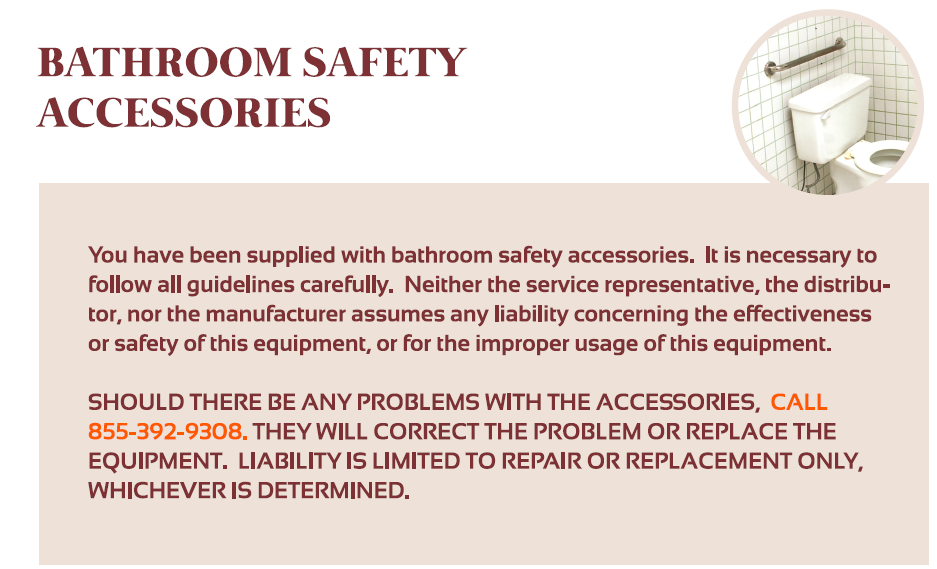
_____ 1. Patient/caregiver has received and understands manufacturers instructions for proper use of the equipment.
_____ 2. Patient/caregiver demonstrates the proper and safe use of bathroom safety accessories.
_____ 3. Patient/caregiver is able to correctly clean and perform preventive maintenance of all types of bathroom safety accessories in accordance with manufacturers guidelines and company policy, with use of proper materials and tools.
_____ 4. Patient/caregiver is able to respond to bathroom safety accessory problems in an appropriate and timely manner.
_____ 5. Patient/caregiver verbalises an understanding of the need to contact Express Rx if the equipment malfunctions.
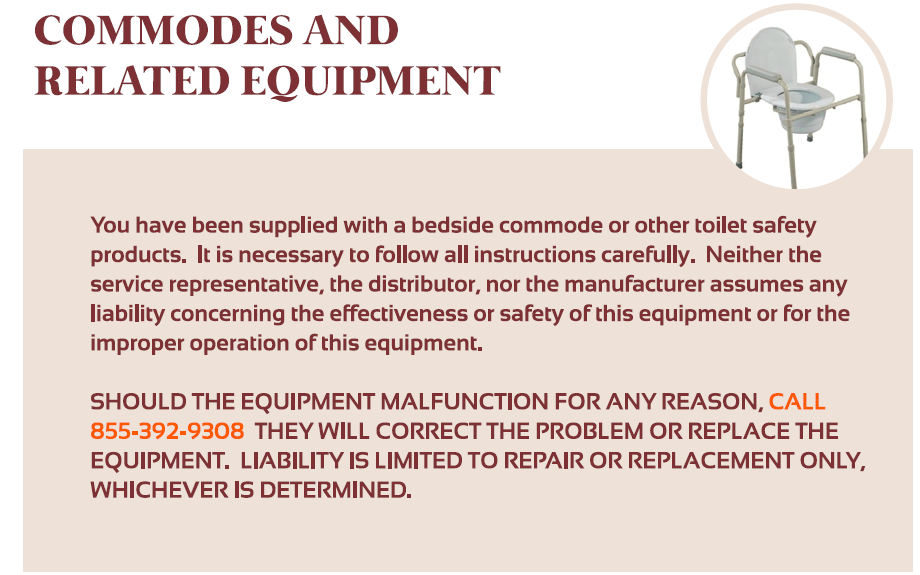
GENERAL INFORMATION:PATIENT/CAREGIVER WILL DEMONSTRATE:
____ Adjustment of the legs on commode or 3-in-1 unit to proper height.
____ Removal of pail for cleaning, and replacement of same.
____ Use of wheels in the case of mobile commode.
____ Use of drop-arms in this type of commode; emphasize locking of arms in up position during use. Discuss transfer of patient from side of commode.
____ Need for regular cleaning of unit to promote good hygiene.
____ Proper attachment of elevated commode seat to toilet bowl if this unit is being delivered. Potential loss of balance and/or tipping with these units.
Safety/Maintenance:
____ Always check equipment for proper function to ensure safety.
____ Potential hazards of equipment: i.e., loss of balance with all types of this equipment (but especially with elevated seat types), pinch points, sharp edges on some aluminum and steel commodes, etc.
____ Patient and caregivers have information necessary to contact Express Rx.
____ Precautions in case of an emergency.
____ Importance of notification of Express Rx in the event of malfunction or faulty parts on unit.
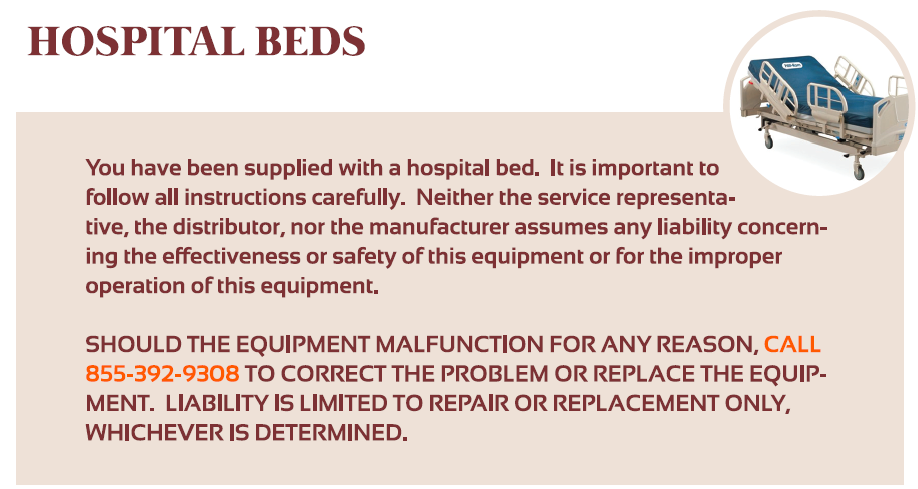
GENERAL INFORMATION:
___ Patient and caregivers that will operate equipment should participate in training; no one else should operate equipment.
Patient/Caregiver Will Demonstrate:
___ Use of hand cranks (manual bed), patient controls (electric bed) or combination of both (semi-electric bed) to effect proper positioning of patient.
___ Use of emergency crank in event of power outage or motor failure in an electric or semi-electric bed.
___ Proper positioning and use of side rails. Emphasize need to always keep side rails up when patient is in bed to prevent falls.
___ Use of wheel locks to prevent movement of bed during use.
___ Understanding the importance of not using side rails to pull patient into position, discuss potential for breakage of rails.
Safety/Maintenance:
___ Discuss need to always check equipment for proper function to ensure safety.
___ Demonstrate potential hazards of equipment: i.e., pinch points, detachment of rails, breakage of rails, need to lock wheels to prevent rolling of bed, need to keep rails up, etc.
___ Emphasize need to keep bed and mattress clean and sanitary.
___ Emphasize importance of notification of Express Rx in the event of malfunction or faulty parts on unit. ___ Ensure that patient and caregivers have information necessary to contact Express Rx.
___ Precautions in case of an emergency.
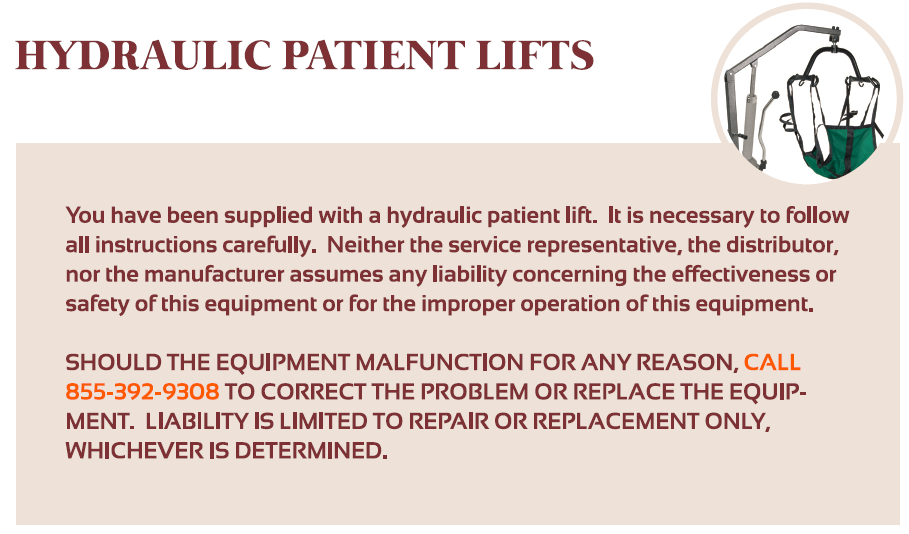
General Information:
___ Patient and caregivers that will operate equipment will participate in training; no one else should operate equipment.
Patient/Caregiver Will Demonstrate:
___ Attachment and proper adjustment of the chains and sling according to manufacturers operations manual(s).
___ Lifting the patient with the patient lift; emphasize the need for proper seating position in the sling.
___ Rotation of the lift to allow placement of patient into chair. Lower sling into chair.
___ Release technique for sling
___ Return demonstration of complete operation of lift.
Safety/Maintenance:
___ Always check equipment for proper function to ensure safety.
___ Potential hazards of equipment: i.e., weak points developing in sling, chain improperly attached or adjusted, base frame not spread properly, patient out of safe center of gravity resulting in tipping, etc.
___ Proper cleaning/laundering of sling and other parts of unit in compliance with manufacturers recommendations.
___ Emphasize importance of notification of Express Rx in the event of malfunction or faulty parts on unit.
___ Ensure that patient and caregivers have information necessary to contact Express Rx.

SUCTION PROCEDURE
Wash hands thoroughly with soap and warm water prior to use of your suction equipment.
SUCTION MACHINE GENERAL INFORMATION
1. Place suction on flat surface.
2. Plug the suction machine into grounded electrical outlet or according to manufacturers recommendations.
3. Assemble and test for optimal vacuum levels.
ENDOTRACHEAL SUCTION
1. Wash your hands.
2. Open suction catheter kit.
3. Prepare oxygen source (if applicable).
4. Open sterile water or normal saline.
5. Fill container with sterile water or normal saline.
6. Glove one hand with non-sterile glove and other with sterile glove.
7. Using hand with sterile glove, pick up catheter at end containing control port.
8. Connect suction catheter to long suction line by using hand with non-sterile glove.
9. Keep fingers off the suction port.
10. Using non-sterile hand, turn suction machine power on.
11. Keeping fingers off the suction port, gently introduce catheter via appropriate route (E.T. tube, Trach Tube). Once resistance has been met, retract catheter l-2 cm and begin applying suction by covering suction port intermittently.
12. Apply intermittent suction as catheter is being removed, rotate catheter while removing. Limit suctioning time to less than 15 seconds.
13. Once catheter has been removed, rinse catheter and connecting tubing by suctioning sterile water or normal saline through the tube.
14. Repeat steps 10-12 if needed.
15. Detach catheter from suction tubing, remove glove and dispose of glove, catheter, and suction kit.
16. Wash hands.
17. Note thickness, color, and amount of secretions obtained.

ABOUT OXYGEN
Oxygen is not addictive. The more you comply with your prescription, the more benefits from it you will obtain. Oxygen is a drug and has been prescribed by your physician. An exact flow rate in liters per minute has been ordered to increase the oxygen level of your blood.
This flow rate must never vary from what your doctor prescribes. Your doctor may have prescribed your oxygen for 24-hour use, use only during sleep, use only during exercise, or use only during acute episodes of shortness of breath. Always use your oxygen according to your prescription.
Oxygen is not flammable, nor does it explode. However, oxygen will make a fire burn quicker. To avoid the chances of a fire:
- Never smoke while using your oxygen concentrator.
- Do not use open fire or flames near the oxygen concentrator.
- Keep all electrical equipment (electric razors, heaters, blankets) at least 5 feet from your oxygen).
- Keep away from sources of heat (stove, space heater, radiator, fireplace). Do not store on or near a heater, or any enclosed space.
- Never use grease or oil on oxygen equipment. Keep equipment away from all flammable materials such as oil, grease, aerosols, paints, gasoline and solvents. Do not use petroleum jelly with oxygen. Use water-based lubricants to moisten your lips or nostrils, if necessary.
- Never store any cylinder in closet or unventilated space. Do not place your oxygen equipment in a small or unventilated storage area. Any venting oxygen could create a fire hazard. Large, unventilated storage areas can be dangerous as well.
- Oxygen cylinder should never be stored or transported in the trunk of a car; and that the tank should be secured by a seat belt when in transit.
- Never use oil-based face or hair creams, aerosol sprays, a hair dryer or an electric razor. It is possible in certain conditions that the combination of oxygen, oil-based toiletries and a spark from an electrical appliance, such as an electric blanket, hair dryer, electric razor or heating pad, could ignite and cause burns. Always use water based cosmetics or creams.
- Secure cylinder at all times in a base or cart. Oxygen cylinders need to be secured in a special base to keep the cylinder from falling over. The weight of the cylinder can damage property and people if it were to fall on something or someone. The cylinder valve could also be knocked off if the cylinder were to fall over. The high pressure coming out of the valve opening could then cause the cylinder to move about the room in a destructive,uncontrolled manner.
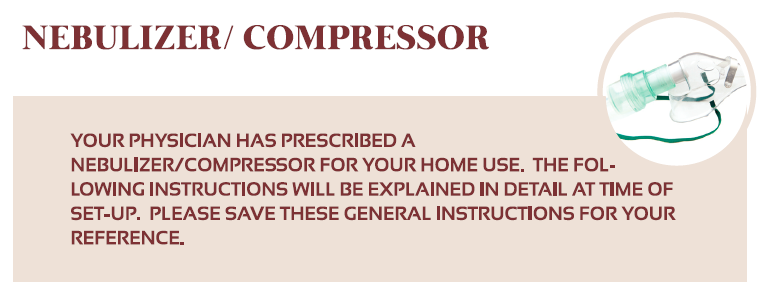
THERAPY INSTRUCTIONS:
1. Connect power cord. (Be sure to use a grounded outlet.)
2. Connect all tubing and nebulizer assembly to machine.
3. Mix medication and place in nebulizer.
4. Sit in upright position.
5. Turn machine on.
6. Place mouthpiece in mouth.
7. Inhale a slow deep breath, hold briefly then exhale slowly.
8. Treatment is finished when all medication is used. An average treatment is 10 to 15 minutes.
9. After treatment, turn off machine.
10. Follow cleaning instructions carefully.
CLEANING INSTRUCTIONS:
RINSE AND DRY NEBULIZER AND MOUTHPIECE AFTER EACH TREATMENT & ALLOW TO AIR DRY.
1. After your last treatment of the day, completely disassemble your nebulizer.
2. Wash in hot, soapy water (mild liquid dish detergent).
3. Rinse parts in clean warm water.
4. Soak for 30 minutes in a solution of 1 part distilled white vinegar & 2 parts water.
5. Rinse under warm running water.
6. Shake the parts well and separate to allow air drying on a paper towel.
IMPORTANT:
Do Not leave medication in nebulizer from one treatment to the next. Poor or infrequent cleaning can cause lung infection. Neb kits are disposable & should be replaced when they become discolored or begin to leak & filters should be replaced every thirty (30) days.
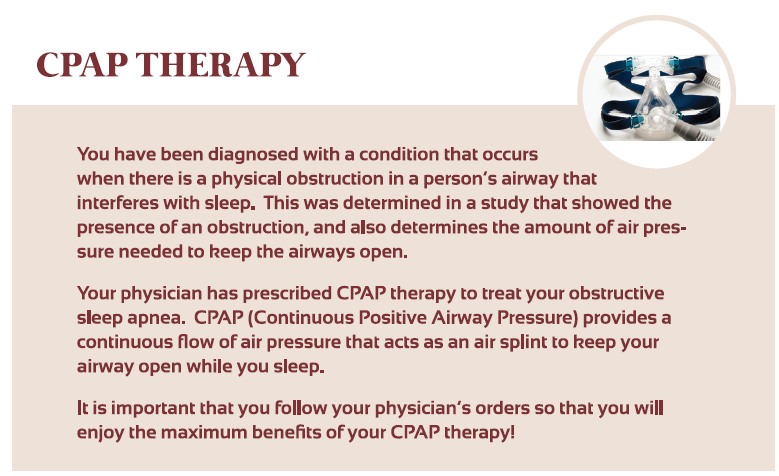
Our trained staff member will instruct you and your family on the proper use of your CPAP unit, tubing, and accessories. At the close of your training session you will be able to do the following:
1. Assemble the entire CPAP equipment.
2. Identify each part by name according to the manufacturer of your particular CPAP unit.
3. Correctly apply your nasal mask or nasal pillow.
4. Correctly clean and/or replace all components as directed by manufacturers guidelines.
5. Identify actions to initiate in case of problems or equipment malfunction.
I. DISCUSSION OF DIAGNOSIS, SYMPTOMS AND CPAP THERAPY RATIONALE
A. Understanding the disease state and its effect on patients life and health.
B. Understanding the physiologic mechanism of the disease.
C. Understanding how CPAP therapy helps correct symptoms; what is CPAP and why is it prescribed.
D. The need for compliance with all physicians orders.
E. Importance of absolute compliance with all aspects of CPAP therapy.
II. APPLICATION/EVALUATION OF THERAPY
A. Patient and/or caregiver to demonstrate ability to:
1. Assemble/disassemble entire patient circuit.
2. Identify each part of the system by name.
3. Correctly and effectively apply the mask.
4. Activate/deactivate the blower unit.
5. Correctly clean and/or replace all components as indicated.
B. Patient must be able to determine adverse effects and take corrective action.
III. PATIENT/FAMILY INVOLVEMENT IN SUCCESSFUL OUTCOME OF THERAPY
A. The importance of closely following the entire treatment program for obstructive sleep apnea.
B. The need for open lines of communication between patient, family, physician, and staff members.
C. The patient should never deviate from or discontinue therapy without permission from the physician.
D. The importance of reporting clinical problems to physician as soon as possible.
E. The importance of reporting equipment problems to Express Rx as soon as possible.
F. The importance of family support and assessment.
** HELPFUL HINTS:
1. Wash your face before using your CPAP unit to remove excess facial oils, to prolong the life of your nasal mask.
2. Once you have been fitted correctly, try to unfasten only one strap when removing the mask to ensure you are maintaining the proper fit.
3. A tighter fit is better, but can be loose as long as there are no air leaks.
4. Keep the back of the headgear flat.
5. If your skin becomes irritated at a pressure point, use a Band-Aid type adhesive strip and contact Express Rx.
6. If you notice the following, please contact your physician:
A. Runny nose
B. Nasal, sinus, or ear pain
C. Obstructive Sleep Apnea symptoms reoccur or persist
D. Lightheadedness or dizziness
Always refer to the manufacturers pamphlet for troubleshooting, cleaning and maintenance.Should the equipment malfunction for any reason, please contact Express Rx 855-392-9308.
PATIENT CHECKLIST OF INSTRUCTIONS FOR PLACEMENT OF BIPAP OR CPAP
1. My doctors order has been explained.
2. Written safety precautions pertaining to this equipment has been presented.
3. Written operating and troubleshooting instructions were presented.
4. Cleaning instructions have been discussed, and written cleaning instructions have been given.
5. Written preventive maintenance and warranty information has been provided. I understand I am responsible for maintenance of purchased equipment.
6. I have performed the procedure to use this equipment in the presence of a representative.
7. I have received the 24-hour emergency phone number, and know to call 911 for medical emergencies.
8. I understand additional supply items can be ordered through Express Rx Inc.
Your TENS Unit kit should contain:
1 - TENS Unit
1 - 9v battery
4 - silicon rubber electrodes
2 - leadwires
24 - electrode adhesives
1 - tube electrode conductivity gel
1. Use fresh 9V battery
2. Shave (if needed), clean and dry thoroughly the location where electrode is to be placed.
3. When inserting or removing wiring, hold the pin connector and not the cord to prevent damage to the wiring.
4. Apply gel in a thin even layer onto the electrode.
5. Clean silicon rubber electrodes with soap and water frequently. Dry thoroughly before using.
6. Use the unit only as directed by your physician. (See instruction booklet for operation)
If your are using a Multiday patch:
- Follow guidelines above
- When daily treatment is finished, remove wiring from electrodes only. Do not remove electrodes from skin.
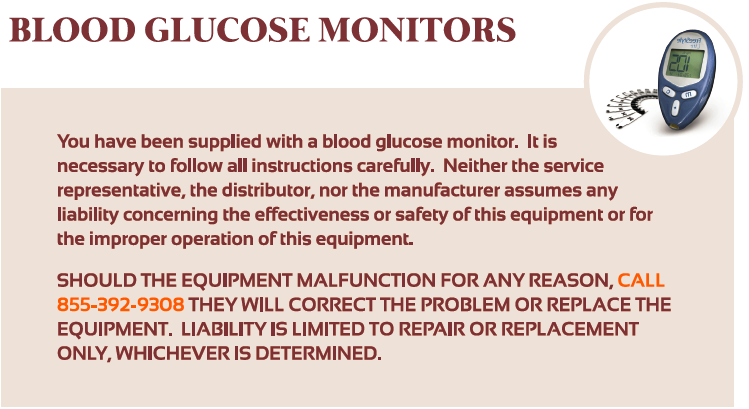
GENERAL INFORMATION
General Information
____ Train patient and caregivers in accordance with equipment manufacturers training and operation manual(s).
____ Complete and file, if applicable, manufacturers educational checklist.
____ Review and witness patient demonstration of all steps for testing, calibration, obtaining blood sample, skin preparation, cleaning and maintenance,etc. Check patients ability to perform all steps proficiently.
____ Confirm patients knowledge of physicians orders concerning frequency of testing, desired technique, etc.
SAFETY/MAINTENANCE:
____ Importance of frequently calibrating unit to ensure accurate readings.
____ Need to keep unit cleaned in accordance with manufacturers guidelines,
____ Toll-free help lines for troubleshooting unit. Discuss warranty coverage offered.
____ Patient and caregivers have information necessary to contact us if indicated (telephone numbers, addresses, etc.).
____ Discuss precautions in case of an emergency.
You have been supplied with a blood glucose monitor. It is necessary to follow all instructions carefully. Neither the service representative, the distributor, nor the manufacturer assumes any liability concerning the effectiveness or safety of this equipment or for the improper operation of this equipment. SHOULD THE EQUIPMENT MALFUNCTION FOR ANY REASON, CALL 855-392-9308 THEY WILL CORRECT THE PROBLEM OR REPLACE THE EQUIPMENT. LIABILITY IS LIMITED TO REPAIR OR REPLACEMENT ONLY, WHICHEVER IS DETERMINED.
ENVIRONMENTAL SAFETY
1. WALKWAYS
- Remove throw rugs whenever possible to avoid tripping.
- If you cant remove throw rugs, use rugs with non-skid backing to avoid slipping.
- Repair or replace torn carpeting to avoid tripping.
- Make the transition between types of flooring (such as wood flooring to carpeted floor) as even as possible and secure to prevent tripping.
- Avoid waxing wood or linoleum floors to prevent slipping.
2. STAIRS
- Rise between steps should ideally be no more than 5 inches.
- Make sure handrails are well anchored (or install handrails) on both sides of the stairway.
- Non-skid treads can be placed on wooden stairs to prevent slipping.
- Make sure carpeting on stairs is secure.
3. FURNITURE LAYOUT
- Arrange furniture so that pathways are not cluttered.
- Chairs and tables need to be sturdy and stable enough to support a person leaning on them.
- Avoid furniture with sharp edges and corners - if furniture does have sharp edges or corners, pad them.
- Chairs with arm rests and high backs provide more support when sitting and more leverage when getting in and out of the chair.
4. LIGHTING
- Be sure that your lighting is ample to prevent falls and to assure that you can read medication labels and instructions easily.
- Light switches should be immediately accessible upon entering the room.
- Good lighting in hallways, stairs, and bathrooms is especially important.
5. MEDICINES
- Keep medicines out of the reach of children. If you keep your medicines out, be sure to put away, when grandchildren or other small children visit.
- Dispose of expired medicines properly - flushing down the toilet is usually best.
- Contact your city government to see if/when there is a medicine take-back program in your community.
6. SLIDING GLASS DOORS
- Mark sliding glass doors with stickers to prevent someone from walking through the glass door.
BATHROOM SAFETY
1. BATHTUB
- Install skid-resistant strips or rubber mat.
- Use a bath seat if it is difficult to stand during a shower or too difficult to get up out of the tub.
- Install grab bars on the side of the tub or shower for balance.
- DO NOT use the soap dish or towel bars for balance - these can pull out of the wall very easily.
- Adjust water temperature to 1200 or less, to prevent scalding.
2. TOILET
- Use an elevated toilet seat or commode if you need support getting on and off the toilet or you are not able to bend your hip normally after surgery.
- Install toilet rails around the toilet if you need more leverage to get off the toilet.
3. DOORS
- Avoid locking bathroom doors or use only locks that can be opened from both sides when you may need assistance in the bathroom.
KITCHEN SAFETY
- Store frequently used items at waist level - use a Reacher or Grabber to avoid standing on a chair or footstool when items are not at eye level.
- Mark ON and OFF positions clearly on the dials of the stove.
- Use the front burners of the stove to avoid reaching over burners (unless there are small children in the home - in that case, use back burners).
- Make sure pan/pot handles are not over other burners and not over the edge of the stove.
- Slide heavy pans across the stove instead of trying to lift them.
- Keep baking soda near the stove to extinguish small cooking fires and keep a fire extinguisher in the kitchen if possible.
- Make sure the sleeves of your clothing are not loose or dangling while cooking - they could easily catch fire.
- Tables with 4 legs are more stable than pedestal-type tables.
EARTHQUAKE PREPAREDNESS
1. BEFORE
- Keep a 1-2 week supply of food/water on hand and consider any special dietary needs or formulas you may use.
- Store a 1-2 week supply of medications and/or medical supplies you will need (insulin, syringes, dressings).
- Know the procedure to follow if you are using medical equipment that runs on electricity and there is a power failure (ventilators, IV pumps, feeding pumps).
- Block or lock wheels of items such as hospital beds, commodes, and refrigerators.
- Persons who live alone should appoint an official buddy (neighbor, family member, friend) who will check on them after an earthquake.
- Anchor tall furniture to the wall and remove heavy items from the top shelves.
2. DURING
- If inside, stay inside and take cover under a heavy desk, table, or doorway away from windows or objects which may fall.
- Drag a bed bound patient (or transfer them to a wheelchair) to move to a safe area.
- Lock the wheels on a wheelchair after moving to a safe area.
- If outside, stand away from trees, electrical lines, and buildings.
3. AFTER
- Home infusion patients should go to the nearest emergency room if you run out of medications, solutions, or supplies and are unable to contact us. We will attempt to contact patients as soon as possible after an earthquake.
- If necessary, use an Ambu bag for a ventilator-dependent patient until you can connect to a back-up system.
- Turn off gas at the meter if you smell gas or hear hissing near gas appliances. DO NOT LIGHT ANY MATCHES IF A GAS LEAK IS SUSPECTED.
- Assess for injuries and be prepared to administer First Aid
- Turn on a portable radio to listen for instructions from Public Safety Agencies.
ELECTRICAL SAFETY
- Keep appliances away from water - Dropping water on an appliance or dropping an appliance into water (tub, sink, etc.) can cause electrocution.
- Use only appliances in good repair - Dont use lamps or appliances that appear to have a short when operated.
- Inspect cords - Dont use appliances with cords that are frayed or have wires exposed. Grounded plugs - Use grounded plugs or 3-prong adapters for medical equipment.
- Proper use of extension cords - keep cords out of pathways to avoid excessive wear and prevent tripping.
- Proper use of octopus plugs - Dont plug multiple appliances into an electrical outlet to prevent overheating the plug
FIRE PREVENTION AND RESPONSE
- Smoke Detectors are recommended in each bedroom, each hallway, and in the kitchen.
- A Fire Extinguisher (ABC type) should be mounted or stored in a central and accessible area - make sure the extinguisher is functioning and that all caring for you know how to use it.
- DO NOT smoke in bed - it is a very hazardous fire danger.
- DO NOT smoke while watching TV if you are sleepy or prone to fall asleep.
- Have an evacuation plan. - Someone who is bed bound will need to be placed in a wheelchair and removed or placed on a blanket and dragged away from danger. - Keep a hospital bed placed in the home (or the bedroom of someone who is ill) close to an exit. - Plan how to get someone who is ill, out of an apartment that is not on the first floor - know where the stairs are.
- Space Heaters - keep away from furniture, cords, curtains, or other items that could ignite. Keep away from walkways where they can be bumped and cause burns.
- Fireplaces - Make sure you have a fireplace screen.
- Oxygen - Keep away from heat sources and open flames (including smoking) - oxygen is highly flammable. Post signs prohibiting smoking.
- Fire Response - Make sure you and all caring for you know how to use 911 for emergencies.
